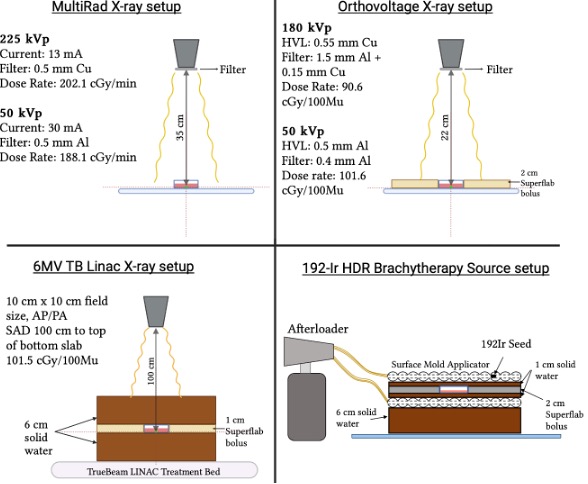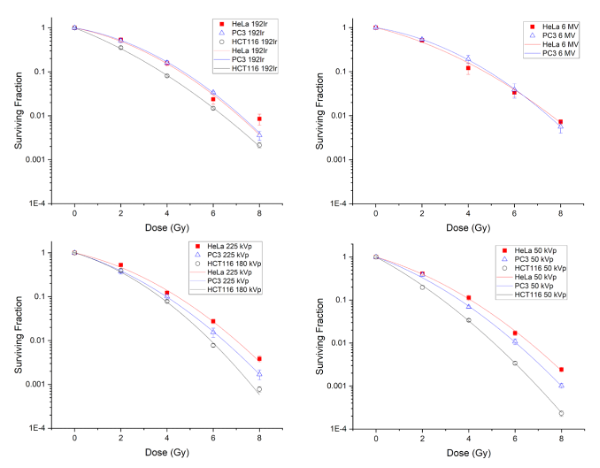Characterization of the RBE of various photon radiation qualities on human cancer cell lines
PO-2225
Abstract
Characterization of the RBE of various photon radiation qualities on human cancer cell lines
Authors: Naim Chabaytah1,2, Joud Babik2, Joanna Li3,7, Behnaz Behmand2, Tanner Connell3, Micheal Evans3, Russell Ruo3, Hamed Bekerat3,6, Shirin A. Enger3,4,5, Te Vuong3,6
1McGill University, Biological and Biomedical Engineering, Montreal, Canada; 2Research Institute of the McGill University Health Centre, MPU, Montreal, Canada; 3Medical Physics Unit, McGill University, Oncology, Montreal, Canada; 4Research Institute of the McGill University Health Centre, Oncology, Montreal, Canada; 5Lady Davis Institute for Medical Research, Jewish General Hospital , Oncology, Montreal, Canada; 6Jewish General Hospital, Oncology, Montreal, Canada; 7Lady Davis Institute for Medical Research, Jewish General Hospital, -, Montreal, Canada
Show Affiliations
Hide Affiliations
Purpose or Objective
To investigate the relative biological effectiveness of different photon-based radiation qualities, on various human cancer cell lines: HeLa (cervix), PC-3 (prostate) and HCT116 (rectal).
Material and Methods
Cells were cultured under recommended growth conditions to 80% confluency, synchronized in G0/G1 cell cycle phase by serum starving 18 hours prior to irradiation, then trypsinized and plated for clonogenic assays post-irradiation. Irradiation with low LET photons for HeLa and PC3 include 6 MV TB Linac x-rays, and 225 and 50 kVp x-rays, and for HCT116 include 180 and 50 kVp x-rays. All 3 cell lines were also irradiated with a 192-Ir HDR brachytherapy source. EBT3 Gafchromic film dosimetry was performed to ensure homogeneous dose distribution and accurate dose delivery of 2, 4, 6, and 8 Gy (0 Gy control). Post-incubation, colonies formed were fixed/stained, and colonies with ≥ 50 cells were counted to calculate survival fractions (SF). Resulting SFs were plotted into survival curves and fitted to the LQ model. RBE values were calculated at the clinically relevant 2 Gy fraction and 10% SF endpoint, using 225 kVp x-rays (or 180 kVp for HCT116) as the reference radiation quality.

Results
The cell killing probability of the investigated photon qualities increased with decreasing photon energies for HeLa, PC-3, and HCT116 cell lines as shown in Figure 1. In all cases, 50 kVp had an RBE >1 whereas 6 MV and 192-Ir irradiations had RBE values <1 as presented in Table 1, with 225 kV (for HeLa and PC-3) and 180 kV (HCT116) x-rays as reference for RBE calculations. HCT116 appears to be the most radiosensitive of the 3 lines tested and HeLa being most radioresistant.

| Photon Quality | Cell Line | Alpha | Beta | A/B | RBE2Gy/0.1SF |
225 kVp (180 kVp for HCT116) | HeLa | 0.3±0.06 | 0.055 ± 0.01 | 4.89± 1.0 | 1 |
| PC3 | 0.4±0.04
| 0.05± 0.006
| 6.7± 0.9
| 1
|
| HCT116 | 0.4±0.06
| 0.07± 0.01
| 5.1±1.7
| 1
|
| 50 kVp | HeLa | 0.4±0.04
| 0.05±0.006
| 7.17±0.9
| 1.17/1.09 |
| PC3 | 0.5±0.04
| 0.05±0.006
| 9.0±2.1
| 1.2/1.1 |
| HCT116 | 0.7±0.04
| 0.05±0.006
| 14.2±2.7
| 1.7/1.3 |
| 6 MV | HeLa | 0.3±0.06
| 0.04±0.009
| 7.46±2.0
| 0.99/0.95 |
| PC3 | 0.2±0.03
| 0.06±0.005
| 3.3±0.6
| 0.72/0.81 |
| 192-Ir | HeLa | 0.2±0.09
| 0.06±0.02
| 4.13±2.0
| 0.95/0.97 |
| PC3 | 0.2±0.03
| 0.06±0.004
| 3.4 ±0.4
| 0.75/0.84 |
| HCT116 | 0.4±0.04
| 0.04±0.005
| 12.2±2.0
| 1.08/0.98 |
Conclusion
Clinically, all photons are considered to have an RBE of 1.0. However, in this study we showed that RBE changes for equal absorbed doses delivered with a range of photon energies. RBE increased with decreasing photon energy across all cell lines. Our results show that MV x-rays have lower RBE than 50 kVp x-rays. The cell lines’ intrinsic capacity to repair DNA damage is seen to also play a role in RBE measurements since the 3 cell lines behaved differently for irradiations with identical setups. Further experiments include DNA repair kinetics modeling to better understand the discrepancies seen in RBE values. Additional experiments are underway to study the RBE of 2 additional HNSCC cell lines, with an HPV + or - status, on the qualities mentioned above. High LET alpha particle irradiations will also be performed on all the cell lines.